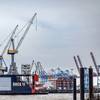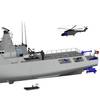More than 80 maritime professionals attended two one-day events focused on the sub IMO / sub 80-ft. sector in Southampton, U.K. this Spring. The Man Overboard Prevention & Recovery Workshop brought together an international group of experts armed with the latest knowledge to identify problems that affect the maritime sector worldwide.
Workshop lead John Haynes opened the day saying said, “Expectations, requirements and capabilities are changing for many maritime organizations. High profile roles are evolving close to shore and offshore in U.K., European and international waters. Challenges may be changing and the use of technology increasing, but safety still remains high on the agenda for professional mariners.”
The Marine Accident Investigation Branch (MAIB) investigates marine accidents involving U.K. vessels worldwide and all vessels in U.K. territorial waters. Inevitably, the MAIB have man overboard (MOB) accidents to investigate, many from commercial fishing vessels, but the lessons from these extrapolate easily to the small commercial sector. The presentation by Captain Andrew Moll, Deputy Chief Inspector of the MAIB, highlighted specific lessons learned from recent incidents that are relevant to all maritime sectors.
Captain Don Cockrill, Secretary General of the U.K. Maritime Pilots Association went on to look at the issues related to ‘Man Overboard around Ships, Workboats and Port Support Vessels.’ Maritime Pilots are required to board and safely navigate vessels into and out of most ports around the world. The size of modern ships has increased, plus movements of the ship and the pilot cutter in heavy seas can be the equivalent of an elevator going up and down between floors in seconds. Unimpeded spilt second judgment is often required. This presentation looked at the potential suitability of the numerous workboats and support vessels operating in the modern port for locating and recovering a casualty in the water.
Every pilot’s nightmare is to fall off the ladder while boarding. Although such incidents are rare, when it does happen there are lessons to be learned by everyone involved – including the casualty.
In February 2011 Captain Jon Stafford, an experienced Pilot with the Port of London Authority, fell from a pilot ladder 6 miles off Margate while boarding a cargo ship at night. He recounted this MOB incident to help others; “I remember looking down to check whether I was falling onto the cutter or into the sea. Fortunately the cutter had moved clear of the ship and was running parallel, close to the ship’s side. I knew then that I wasn’t going to suffer serious injury from falling onto the cutter, but I was going into the icy North Sea in February between the ship and the cutter. As I hit the water my first thoughts were the propellers of first the cutter and then the ship. When I resurfaced I was at the stern of the pilot cutter but the water flow was pushing me hard up against the ship’s side and I knew that it was taking me towards the ship’s propeller.”
He estimated that he passed within a meter of the propeller. Once he had survived that close encounter the cutter crew had to locate him in the dark and get him back onboard.
At this point it was relevant to hear from William Mills, HM Coastguard Maritime Operations Controller, on how an MOB rescue evolves. Search and rescue (SAR) skills require a unique mix of experience, local knowledge and digital technology. This is linked with sophisticated communications between land, sea and air assets.
Sir Robin Knox-Johnston, Chairman of Clipper Ventures, was the first person to sail single handed and non-stop around the world between June 1968 and April 1969. Among numerous sailing achievements he co-skippered ‘Enza New Zealand’ with the late Peter Blake to take the Jules Verne Trophy in 1994 for the fastest circumnavigation of the world. The 11th edition of the Clipper around the world yacht race starts later this year and will involve more than 700 crew on board twelve 70 ft. yachts which comply with the MCA’s rules for commercially operated yachts. Sir Robin discussed actual incidents on the open ocean, the lessons learned and applied to prevent people falling over the side, finding them quickly in poor conditions and their recovery on board.
Maritime medical solutions consultant, Paul Savage of Saviour Global Solutions, is Chairman of the U.K. Search and Rescue Medical Group which shapes the future and direction of U.K. SAR medicine. Drawing on nearly 30 years of search and rescue service with the RNLI and HM Coastguard, combined with the latest medical research, he explained the detail of what actually happens to the human body’s physiology when immersed or submersed in cold water. His presentation titled, ‘7 Ways To Die In Cold Water’ highlighted crucial factors that can help survival.
To end the day JoJo Mains, Community Safety Intelligence Manager for the RNLI, discussed how the organization uses analysis of incident statistics from a broad range of ‘on water’ and ‘close to water’ activities to develop and refine safety interventions, manage risk and target behaviour change that can bias participants toward safety. This includes fundamentals such as wearing lifejackets and adopting a means of low resource MOB recovery, particularly for short-handed crews.
Doug Vincett, Technical Sales & Support for Spinlock, showed its range of lifejackets which have a compact 3D shape with front opening belt system for fast and secure fitting. The wide range of chest and back adjustment allows the wearer to have a comfortable fit which gives increased freedom of movement for working on deck. Vincett said, “If a lifejacket is not comfortable enough to be worn continuously it is useless. Spinlock lifejackets are designed to provide efficient working and reduced fatigue for continuous wear commercial marine applications due to improved design, weight distribution and fit.”
3Si, Safety & Survival Systems International group, has a large portfolio of man overboard recovery products ranging from traditional life rings to electronic devices for commercial and military markets. Alistair Hackett, General Manager of the Ocean Safety division, gave a brief overview of the various types of personal locator beacons. This highlighted how the units are now cost effective for all maritime sectors plus their size is both lightweight and compact.
Sally Dale, Director of Pinpoint Electronics, presented the Life Cell unit which is a SOLAS approved buoyant device that can store safety equipment including VHF, EPIRB, flares, flashlight, air horn, whistle and signalling mirror. The mounting bracket is designed to allow the unit to float free in the event of a vessel sinking, then people in the water can use it as a floatation device. Dale said, “Life Cell was designed and developed after a real-life accident at sea and aims to redefine how safety equipment is stored on boats.”
Harken Industrial demonstrated its lightweight, compact, low-friction, certified MOB kit for singlehanded recovery of a man overboard. Harken Industrial has also developed a range of corrosion-resistant rails and cars that enable crew to move freely around decks with adjustable anchorage points. Andy Ash-Vie, Harken Industrial Group Director said, “From our experience of over 40 years building solutions for the high performance yachting sector, we have developed a range of products for inshore, coastal and short sea applications to make working in adverse conditions easier, safer and more productive.”
The Author
John Haynes, AFNI, is Operations Director of FRC International and a presenter of WBV courses. He is a Yachtmaster Ocean and Advanced Powerboat Instructor. Subject matter expertise includes high speed craft consultancy, product development and specialist training.















